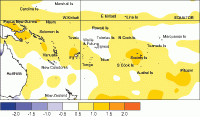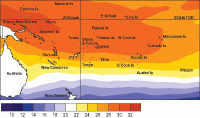Climate developments in June 2006

During June, the SPCZ was displaced further north and west than average, with enhanced convection extending from Papua New Guinea east over the Solomon Islands and the seas north of Vanuatu. The SPCZ was rather inactive to the east of the Date Line. Enhanced convection also occurred southeast of the Southern Cook Islands. Rainfall was at least 200% of average in central and southern Tonga and Niue, at least 150% of average in parts of central French Polynesia, and near or above average over much of southern French Polynesia, as well as parts of Eastern Kiribati.
Regions of suppressed convection affected New Caledonia and Samoa. Rainfall was 50% or less of average over all of New Caledonia, and 75% or less in Samoa, the Southern Cook Islands, and parts of Viti Levu, Fiji.
Mean air temperatures were 1.0 °C or more below average in parts of New Caledonia and northern Tonga, due to frequent cool southerly airflow. In contrast, they were 1.0 °C or more above average in parts of central French Polynesia.
Tropical Southwest Pacific mean sea-level pressures were above average west of the Date Line, due to more frequent anticyclones south of Australia extending into the Tasman Sea. Pressures tended to be average in the east. Equatorial surface easterlies occurred in 78% of observations at Tarawa, a slight increase from May.
| Country | Location | Rainfall (mm) | % of average | Comments |
|---|---|---|---|---|
| Fiji | Ono-i-Lau | 260 | 296 | Well above average |
| Niue | Hanan Airport | 201 | 223 | Well above average |
| Tonga | Fua’amotu Airport | 359 | 355 | Record high |
| New Caledonia | Moue | 41 | 31 | Record low |
Soil moisture in June 2006

Estimates of soil moisture shown in the map (above) are based on monthly rainfall for one station in each country. Currently there are not many sites in the water balance model. It is planned to include more stations in the future.
The information displayed is based on a simple water balance technique to determine soil moisture levels. Addition of moisture to available water already in the soil comes from rainfall with losses via evapotranspiration. Monthly rainfall and evapotranspiration are used to determine the soil moisture level and its changes.
Please note that these soil moisture calculations are made at the end of the month.For practical purposes, generalisations were made about the available water capacity of the soils at each site.
At the end of June 2006, Tarawa, Apia, Fua'amotu, and Hanan Airport were at field capacity (full). Nadi and Rarotonga soils were at soil moisture capacities, typical for the time of the year.
El Niño/Southern Oscillation (ENSO)


The tropical Pacific is in a neutral state. Equatorial Pacific sea surface temperature anomalies have risen almost 1°C in the past 3-4 months and are now positive across most of the basin, except in the far east. The NINO3 SST anomaly for June was about +0.3°C (+0.2°C for April-June) and NINO4 was about +0.6°C (+0.3°C for April-June), both having warmed from a near zero anomaly in April 2006.
The thermocline has deepened significantly since March from about 150°W eastwards, and weak positive temperature anomalies exist at all longitudes in the top 100 m. The Southern Oscillation Index (SOI) was -0.7 in June, showing little change from May, with the April-June mean at +0.0. The trade winds were close to their normal strength across the Pacific in June. The NASA ENSO precipitation index for June was -1.1, which is indicative of a La Niña-like convection pattern, caused by southward displacement of the northern branch of the ITCZ, and higher precipitation over New Guinea and eastern Indonesia.
Some global ENSO forecast models suggest the recent warming will continue, with three predicting a weak El Niño state by late 2006. Moat models, however, are predicting continued neutral conditions. The NCEP synopsis is for neutral conditions during July-September, and an uncertain outlook for the remainder of the year. The IRI now indicates neutral ENSO conditions are favoured for the remainder of 2006.
Madden-Julian Oscillation (MJO) and Subtropical highs
The Madden-Julian Oscillation (MJO), an eastward progression of both enhanced and suppressed tropical rainfall cycling at 30 – 60 days, is an equatorial travelling pattern of anomalous convection. The MJO has been fairly weak, but has been showing a regular 30-day periodicity recently. Over recent months, convection increased again in mid June in the central Indian Ocean, and is expected to affect the western Pacific in the first week of July.
The Subtropical High pressure belt and those of the migratory anticyclones in the south west Pacific normally lies to the south of most island groups at 29°S. In June, west of the Date Line, it was further south than normal and particularly strong, being centred over southeastern Australia. This dominated climate patterns in the North Tasman/Coral Sea regions. East of the Date Line it was further north than normal and weaker.
